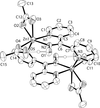issue contents
February 2024 issue

Cover illustration: Vanillic acid (4-hydroxy-3-methoxybenzoic acid) is an aromatic phenolic acid widely used as a flavouring agent in the food industry. In addition to being a flavourant, this compound offers remarkable therapeutic effects and more recently has been reported to be a promising linker precursor towards novel coordination polymers. Prop-2-ynyl 3-methoxy-4-(prop-2-ynyloxy)benzoate was investigated as an intermediate toward hydroxamic acid-type linker systems and was prepared via the alkylation of 4-hydroxy-3-methoxybenzoic acid with propargyl bromide in the presence of K2CO3. There are two crystallographically independent molecules in the asymmetric unit, linked via C—H⋯O interactions to form dimeric entities. The allylic groups are twisted out of the phenyl planes with dihedral angles varying between 7.92 (13) and 25.42 (8)°. In the crystal, the packing follows a zigzag pattern along the c-axis direction. See: Moodley, Muller & Belay [IUCrData (2024). 8, x240163]
metal-organic compounds


 access
access

 access
access

 access
accessorganic compounds


 access
access

 access
access
 journal menu
journal menu
















![[publCIF]](/logos/authorchecklist11.gif)





